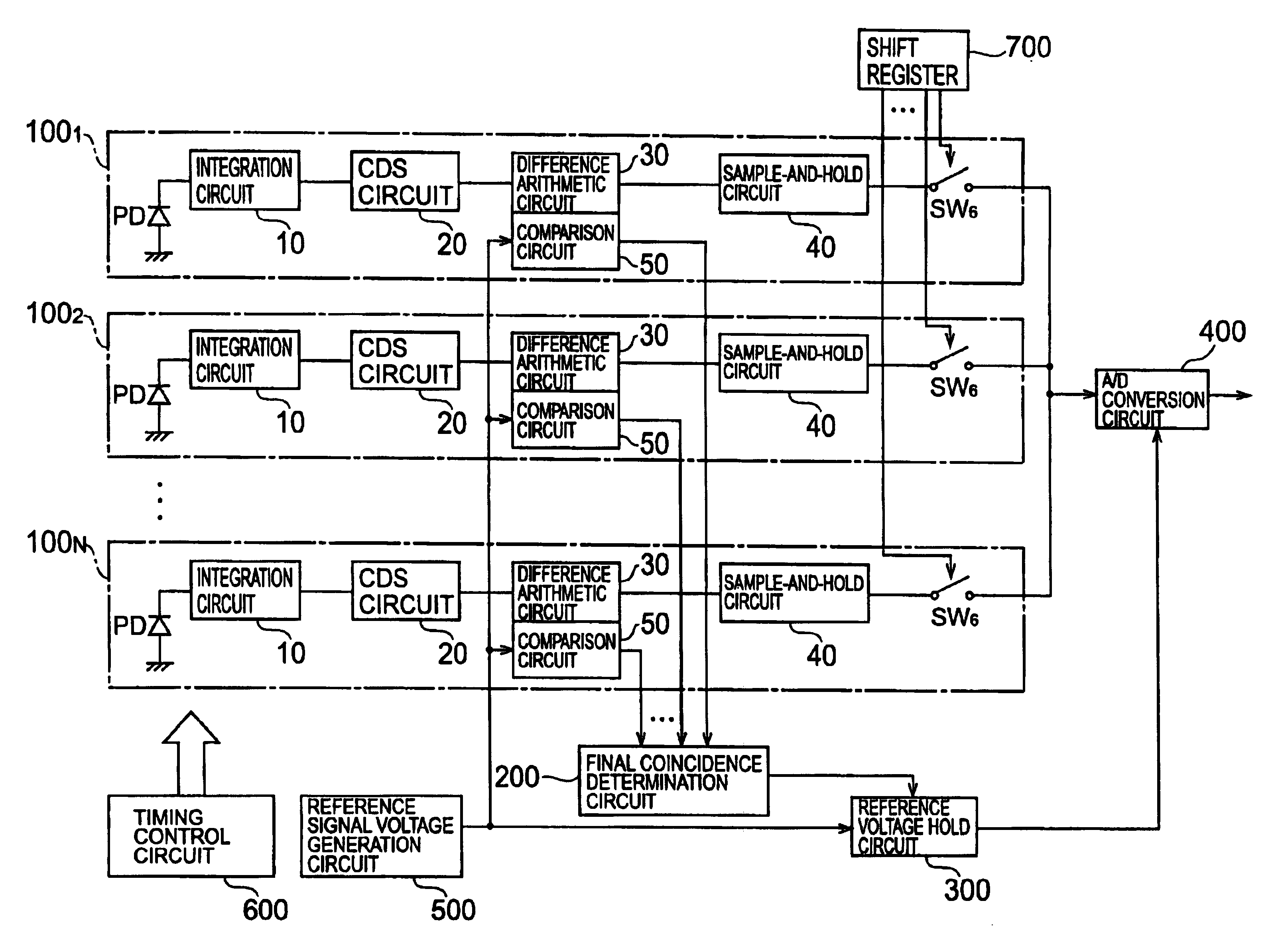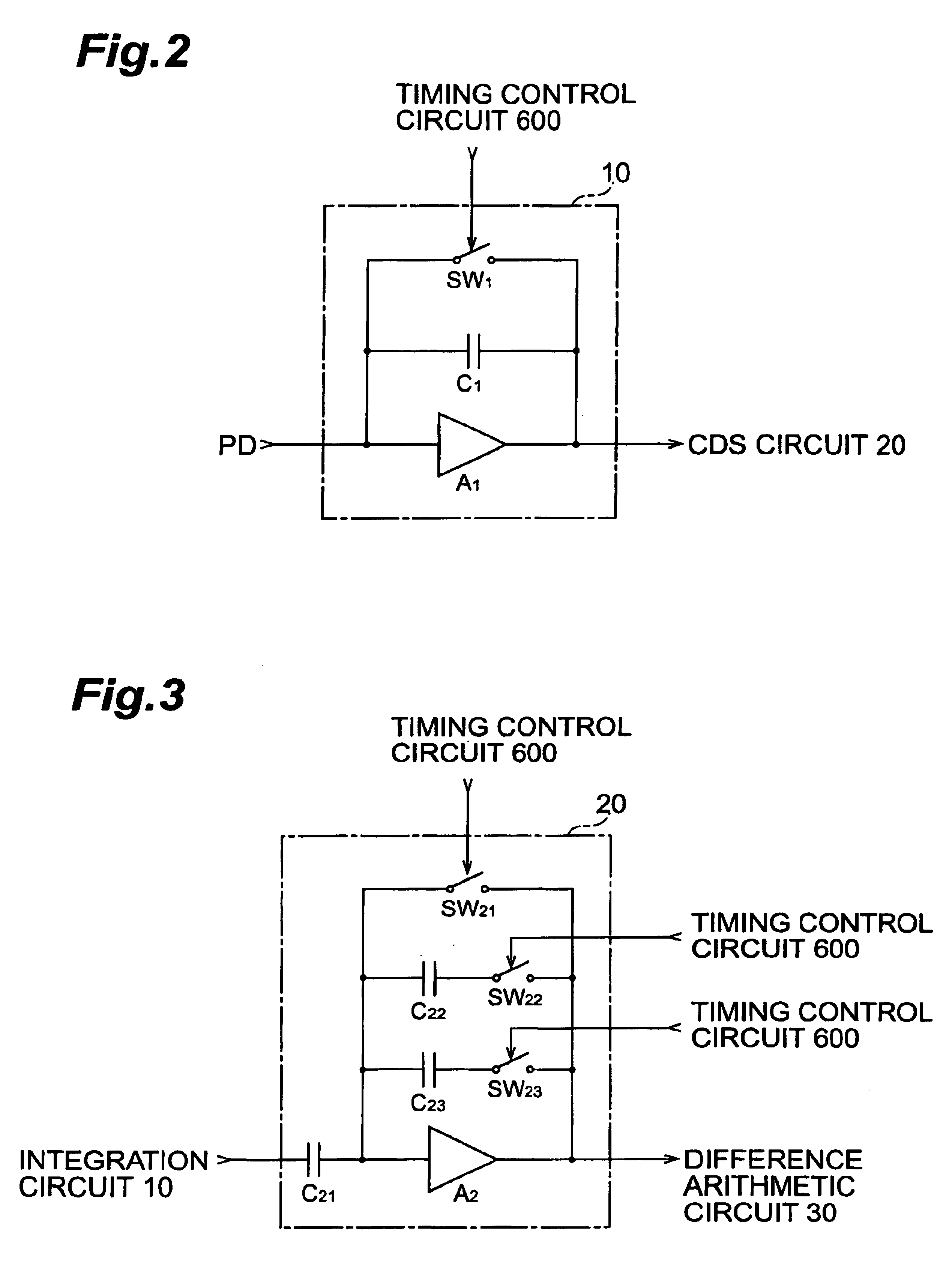Solid-state imaging device and distance measuring device
- Summary
- Abstract
- Description
- Claims
- Application Information
AI Technical Summary
Benefits of technology
Problems solved by technology
Method used
Image
Examples
first embodiment
(First Embodiment)
[0034]The arrangement of a solid-state imaging device according to the first embodiment will be described first with reference to FIGS. 1 to 9. FIG. 1 is a schematic view of the overall arrangement of the solid-state imaging device according to the embodiment. The solid-state imaging device according to this embodiment comprises N units 1001 to 100N, a final coincidence determination circuit 200, a reference voltage hold circuit 300, an AID conversion circuit 400, a reference signal voltage generation circuit 500, a timing control circuit 600, and a shift register 700.
[0035]Each unit 100n includes a photodiode PD, an integration circuit 10, a CDS circuit 20, a difference arithmetic circuit 30, a S-H circuit 40, a comparison circuit 50, and a switch SW6. The integration circuits 10 of the units 100n have identical arrangements. The CDS circuits 20 of the units 100n have identical arrangements. The difference arithmetic circuits 30 of the units 100n have identical ar...
second embodiment
(Second Embodiment)
[0083]The arrangement of a solid-state imaging device according to the second embodiment will be described next. The solid-state imaging device according to the second embodiment is different from the first embodiment in the circuit arrangements of a difference arithmetic circuit 30 and comparison circuit 50. FIG. 12 is a circuit diagram of the difference arithmetic circuit 30 and comparison circuit 50 of the solid-state imaging device according to the second embodiment.
[0084]The difference arithmetic circuit 30 of each unit 100n has a capacitor C3 and amplifier A3 sequentially between the input terminal and the output terminal. The connection point between the capacitor C3 and the amplifier A3 is grounded through a switch SW3. When the switch SW3 is ON, the difference arithmetic circuit 30 stores only charges Q1 in the capacitor C3. When the switch SW3 is OFF, the difference arithmetic circuit 30 removes charges Q2 from the capacitor C3. With this operation, the ...
third embodiment
(Third Embodiment)
[0088]The arrangement of a solid-state imaging device according to the third embodiment will be described next. The solid-state imaging device according to the third embodiment is different from the second is embodiment in the circuit arrangement of a comparison circuit 50. FIG. 13 is a circuit diagram of a difference arithmetic circuit 30 and comparison circuit 50 of the solid-state imaging device according to the third embodiment.
[0089]The comparison circuit 50 of each unit 100n has two input terminals and one output terminal, and also, a switch SW5, capacitor C5, and differential comparator COMP. The non-inverting input terminal of the differential comparator COMP is grounded through the capacitor C5 and also connected, through the switch SW5, to the first input terminal which receives the signal voltage output from the difference arithmetic circuit 30. The inverting input terminal of the differential comparator COMP is connected to the second input terminal whi...
PUM
 Login to View More
Login to View More Abstract
Description
Claims
Application Information
 Login to View More
Login to View More - R&D
- Intellectual Property
- Life Sciences
- Materials
- Tech Scout
- Unparalleled Data Quality
- Higher Quality Content
- 60% Fewer Hallucinations
Browse by: Latest US Patents, China's latest patents, Technical Efficacy Thesaurus, Application Domain, Technology Topic, Popular Technical Reports.
© 2025 PatSnap. All rights reserved.Legal|Privacy policy|Modern Slavery Act Transparency Statement|Sitemap|About US| Contact US: help@patsnap.com



